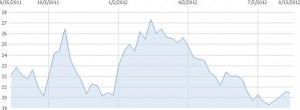American taxpayers could wind up losing as much as $25 billion on the 2008 – 2009 automotive bailout, according to a new report, a figure that has increased by 15% since an earlier forecast, in large part representing the significant downturn in General Motors’ stock price.
Beginning with the outgoing Bush Administration in 2008 and continuing once Pres. Barack Obama took office the following year, the U.S. Treasury invested $85 billion to help the domestic industry survive the deep recession – primarily to fund the post-bankruptcy turnarounds at GM and Chrysler.
But, in a report sent to Congress, the White House raised to $25.1 billion the amount it said it cannot now expect to recover – primarily by selling off the remaining 26% stake it still holds in GM. The previous quarterly estimate was $21.7 billion. On the other hand, the latest figure is about 45% less than the $44 billion the Obama Administration had once predicted.
The forecast has actually been rising for some months, government analysts last year issuing a projection closer to $15 billion. And, following the November 2010 GM IPO, there was some hope the Treasury might even break even. That was based on some industry research, such as one report from influential Deutsche Bank that initially forecast GM shares could eventually top $50 compared to the IPO strike price of $33.
But, in recent months, automotive shares in general, GM in particular, have been tumbling. The $25 billion government loss forecast was based on a stock price of $22.20 at the end of May. During the last month, however, the number has dipped to less than $19 a share, though the stock has since rebounded to $20.61 at midday today.
GM sold off more than half the shares held by American taxpayers during the 2010 IPO but the Treasury is still the maker’s biggest stockholder at 26% — or 500 million shares. GM’s stock price would need to jump to $53 for the government to break even.
The bailout, though initially started by the prior administration, has become an issue in the current election. GOP presidential candidate Mitt Romney vociferously opposed the rescue effort in 2008 and ’09 – but has since claimed that he helped set the framework that helped GM and Chrysler successfully emerge from bankruptcy.
President Obama has repeatedly defended the bailout, insisting that the long-term cost of allowing GM and Chrysler to go bankrupt would have been significantly more than what the Treasury might ultimately lose on the effort.
A Treasury spokesman, Matt Anderson, continued to defend the bailout this week, insisting, “The auto industry rescue helped save more than 1 million jobs throughout our nation’s industrial heartland and is expected to cost far less than many had feared during the height of the crisis.”
Even at $25.1 billion, the current forecast is less than the original $44 billion the Obama Administration had projected. That’s about the same amount as was authorized by the Bush Administration when it approved the first tranche of bailout money.
Chrysler has paid off all the money it received from the Obama Administration but didn’t cover another $1.3 billion granted by Pres. Bush.
Along with GM, the final accounting on the bailout will have to wait until the Treasury sells off the 74% stake it holds in Ally Financial, the lender formerly known as GMAC. Taxpayers have so far recovered $5.7 billion of the $17.2 billion provided Ally.

